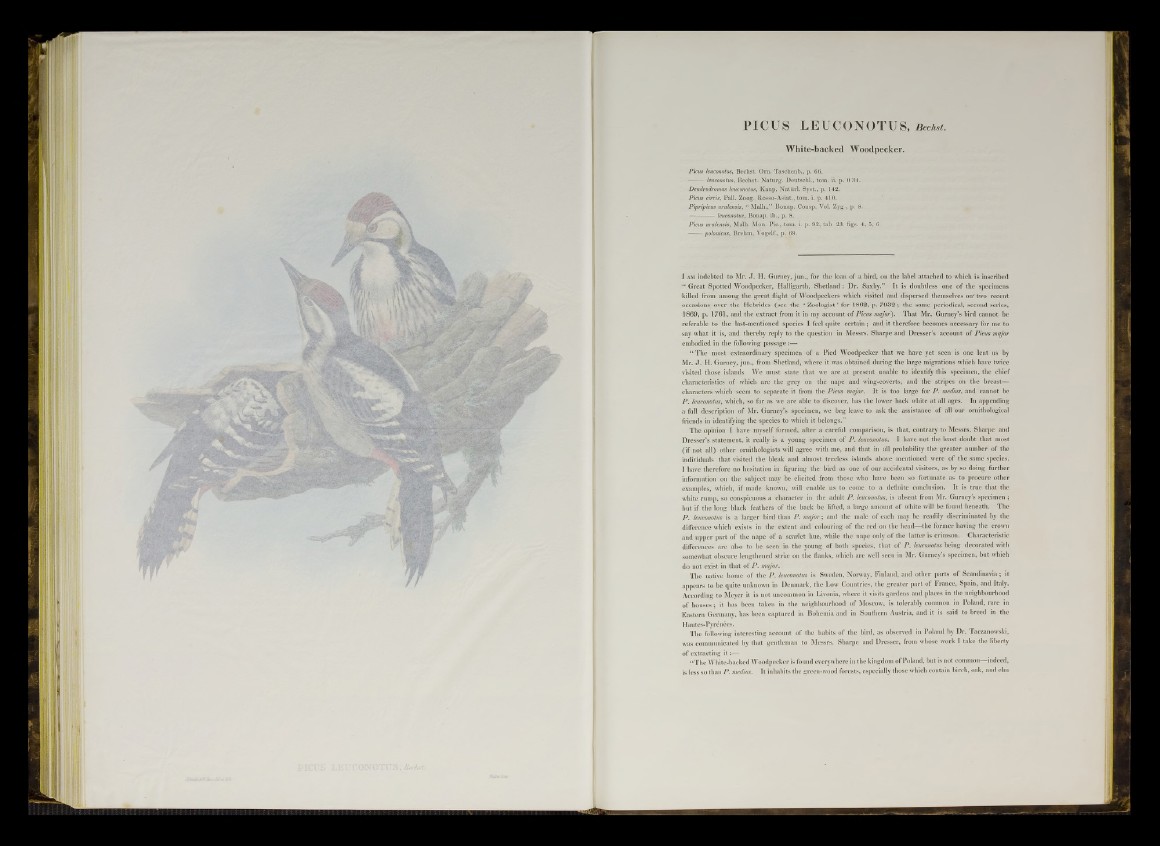
d r ?
PICUS LEUCONOTUS, Bechst.
White-backed Woodpecker.
Picus leuconotos, Bechst. Om. Taschenb., p. 66.
leuconotus, Bechst. Naturg. Deutschl., tom. ii. p. 0 34.
Dendrodromas leuconotus, Kaup, Naliirl. Syst., p. 142.
Picus cirris, Pall. Zoog. Rosso-Asiat., tom. i. p. 410.
Pipripicus uralensis, “ Malh.,” Bonap. Consp. Vol. Zyg., p. 8.
leuconotus, Bonap. ib., p. 8.
Picus uralensis, Malh. Mon. Pic., tom. i. p. 92, tab. 23. figs. 4, 5, 6.
— polonipus, Brehm, Vogelf., p. 69.
I a m indebted to Mr. J . H. Gurney, j u n . , for the loan of a bird, on the label attached to which is inscribed
“ Great Spotted Woodpecker, Halligarth, Shetland: Dr. Saxby.” It is doubtless one of the specimens
killed from among the great flight of Woodpeckers which visited and dispersed themselves on' two recent
occasions over the Hebrides (see the ‘ Zoologist ’ for 1862, p. 7932; the same periodical, second series,
1869, p. 1761, and the extract from it in my account of Picus major). That Mr. Gurney’s bird cannot be
referable to the last-mentioned species I feel quite certain; and it therefore becomes necessary for me to
say what it is, and thereby reply to the question in Messrs. Sharpe and Dresser’s account of Picus major
embodied in the following passage:—
“ The most extraordinary specimen of a Pied Woodpecker that we have yet seen is one lent us by
Mr. J . H. Gurney, jun., from Shetland, where it was obtained during the large migrations which have twice
visited those islands We must state that we are at present unable to identify this specimen, the chief
characteristics of which are the grey on the nape and wing-coverts, and the stripes on the breast—
characters which seem to separate it from the Picus major. It is too large for P. medius, and cannot be
P. leuconotus, which, so far as we are able to discover, has the lower back white at all ages. In appending
a full description of Mr. Gurney’s specimen, we beg leave to ask the assistance of all our ornithological
friends in identifying the species to which it belongs.”
The opinion I have myself formed, after a careful comparison, is that, contrary to Messrs. Sharpe and
Dresser’s statement, it really is a young specimen of P. leuconotus. I have not the least doubt that most
(if not all) other ornithologists will agree with me, and that in all probability the greater number of the
individuals that visited the bleak and almost treeless islands above mentioned were of the same species.
I have therefore no hesitation in figuring the bird as one of our accidental visitors, as by so doing further
information on the subject may be elicited from those who have been so fortunate as to procure other
examples, which, if made known, will enable us to come to a definite conclusion. It is true that the
white rump, so conspicuous a character in the adult P. leuconotus, is absent from Mr. Gurney's specimen ;
but if the long black feathers of the back be lifted, a large amount of white will be found beneath. The
P. leuconotus is a larger bird than P. major; and the male of each may be readily discriminated by the
difference which exists in the extent and colouring of the red on the head—the former having the crown
and upper part of the nape of a scarlet hue, while the nape only of the latter is crimson. Characteristic
differences are also to be seen in the young of both species, that of P. leuconotus being decorated with
somewhat obscure lengthened striae on the flanks, which are well seen in Mr. Gurney’s specimen, but which
do not exist in that of P. major.
The native home of the P. leuconotus is Sweden, Norway, Finland, and other parts of Scandinavia; it
appears to be quite unknown in Denmark, the Low Countries, the greater part of France, Spain, and Italy.
According to Meyer it is not uucommon in Livonia, where it visits gardens and places in the neighbourhood
of houses; it has been taken in the neighbourhood of Moscow, is tolerably common in Poland, rare in
Eastern Germany, has been captured in Bohemia and in Southern Austria, and it is said to breed in the
Hautes-Pyrenees.
The following interesting account of the habits of the bird, as observed in Poland by Dr. Taczanowski,
was communicated by that gentleman to Messrs. Sharpe and Dresser, from whose work I take the liberty
of extracting i t :—
“The White-backed Woodpecker is found everywhere in the kingdom of Poland, but is not common—indeed,
is less so than P. medius. It inhabits the green-wood forests, especially those which contain birch, oak, and elm